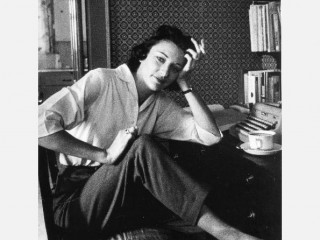
Anne Sexton biography
Date of birth : 1928-11-09
Date of death : 1974-10-04
Birthplace : Newton, Massachusetts
Nationality : American
Category : Famous Figures
Last modified : 2010-12-07
Credited as : Poet, works: To Bedlam and Part Way Back (1960), All My Pretty Ones (1962), Live or Die (1966), Love Poems (1969)
A contemporary American poet, Anne Sexton was best known for the relentlessly autobiographical nature of her poetry and for her personal "confessional" voice, which led some fans to believe, mistakenly, that everything she wrote had actually happened to her.
Anne Sexton was born Anne Gray Harvey on November 9, 1928, in Newton, Massachusetts. The youngest of three daughters born to prosperous parents, Sexton began writing poetry as a result of an emotional breakdown that led to serious depression. Her first of several suicide attempts was an overdose of Nembutal. Despite a lasting relationship with her psychiatrist, Martin Orne, Sexton lived a troubled life. As part of her therapy, Orne suggested Sexton write poetry, and she did. She eloped with and married Alfred Muller "Kayo" Sexton, II, on August 16, 1948.
Sexton began writing seriously in 1957, publishing To Bedlam and Part Way Back in 1960, a collection that won her significant praise for a first book. Though she received little formal training in poetics, claiming to learn meter by watching I. A. Richards on television, her poetry has notable formal sophistication. She is best known for the intensely personal quality of her work that early mentors, including John Holmes, tried to discourage in her. Sexton wrote about subjects that were previously unexplored in poetry, such as abortion, menstruation, and the allure of suicide for her. At a time when the most critically acclaimed poetry was considered "representative" of the human condition, Sexton wrote unabashedly about herself, writing on topics that some found "embarrassing" and others didn't even consider appropriate for poetry. Also noteworthy was the fascination with death that her poetry reveals, a fascination she shared with friend and fellow poet Sylvia Plath, whom she met while taking a writing seminar with Robert Lowell at Boston University. Previously, in a Holmes workshop, Sexton had met and struck up an important and lasting friendship with the poet Maxine Kumin. Kumin was the one with whom Sexton shared her ideas and early drafts of poems. In 1967 Sexton received the Pulitzer Prize for Live or Die (1966) as well as the Shelley Memorial Prize. Other significant awards included a 1969 Guggenheim Foundation grant to work on her play Mercy Street and the American Academy of Arts and Letters travel grant in 1963.
Though there is much scholarly disagreement about which poets should be included in what M. L. Rosenthal labeled the "confessional" school of poetry—so named because of the confessional quality in the work—no one seems to argue with Sexton's placement therein. Others sometimes grouped with her as confessional poets include Robert Lowell, Sylvia Plath, John Berryman, Allen Ginsberg, and Theodore Roethke. While this label is used disparagingly at times to describe Sexton's work, it is certainly an appropriate label, though Rosenthal actually fashioned it for Lowell rather than Sexton.
Despite frequent stays in a mental hospital and continual psychiatric therapy, Sexton published seven poetry collections in her lifetime with three more published post-humously. Her best work is probably found in All My Pretty Ones (1962), which bears an epigraph from Shakespeare's Macbeth. In that collection, too, Sexton professes her commitment to personal, confessional poetry in "With Mercy For The Greedy," writing:
Among her best-known poems are "Her Kind," after which Sexton named the band with which she later performed; "The Abortion"; "Letter Written on a Ferry While Crossing Long Island Sound"; "In Celebration of My Uterus"; and "The Ambition Bird."
Notable in her work is the collection published in 1971 titled Transformations. In these poems Sexton retells some well-known Grimm's fairy tales from the perspective of "a middle-aged witch, me," creating some comic moments and leading to some surprising conclusions that are not part of the original tales.
Sexton was an enormously popular reader on the poetry reading circuit. So popular was she, in fact, that she was able to command reading fees far in excess of those most poets received at the time. She was a glamorous woman— her early career before writing poetry included a brief stint as a model—and she had many fans, both inside and outside academia. Many thought of her as a celebrity first and a poet second.
Sexton made her final—this time successful—suicide attempt on October 4, 1974.
Sexton's works include: To Bedlam and Part Way Back (1960), All My Pretty Ones (1962), Live or Die (1966), Love Poems (1969), Transformations (1971), The Book of Folly (1972), The Death Notebooks (1974), The Awful Rowing Toward God (1975), 45 Mercy Street (1976) and Words for Dr. Y.: Uncollected Poems (1978). Her poems have also been collected in The Complete Poems (1981). Also of interest is Sexton's No Evil Star: Selected Essays, Interviews, and Prose (1992), edited by Steven E. Colburn.
Further information about her life and work can be found in Diane Wood Middlebrook's Anne Sexton: A Biography (1991). Reviews of her work and critical essays can be found in Diane Hume George's Sexton: Selected Criticism (1988); Linda Wagner-Martin's Critical Essays on Anne Sexton (1989); and Steven E. Colburn's Anne Sexton: Telling the Tale (1988). Sexton's The Complete Poems also contains a useful introduction to the poet by her friend and fellow poet Maxine Kumin.
















